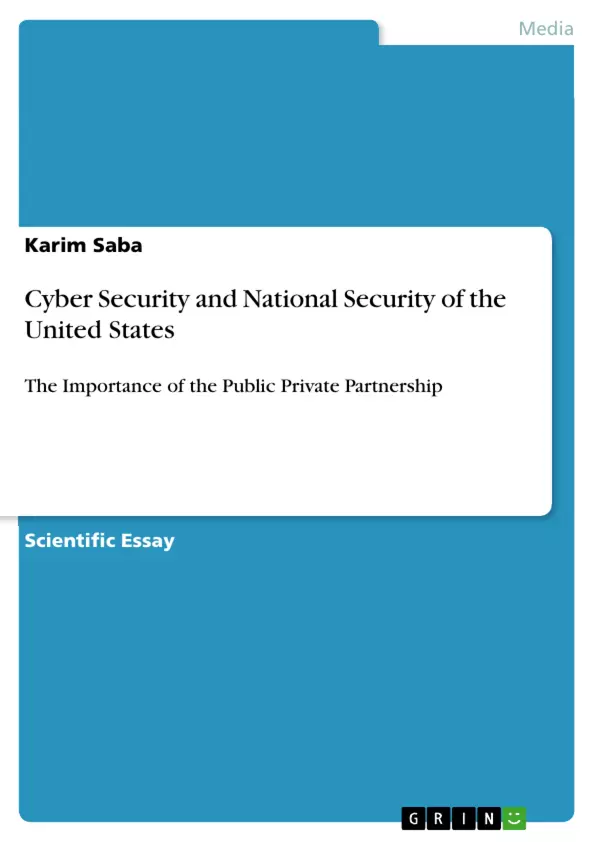The aim of this paper is to argue that the public-private partnership represents the
ultimate solution to protect the national cyber security of the United States against frequent and
violent cyber-attacks. The paper will elaborate the importance of the cyber security to the
national security of the United States, then assesses the present solitary governmental defense
measures, and highlights the loopholes and defects of the current unilateral administrative strategy that does not involve the private sector neither in the decision-making process, nor in the
execution phase of the defense strategy. The paper will also highlight the roles of the White
House, military and intelligence agencies, and subsequently connect them to the proposed
public-private partnership and how this partnership is going to synergize their roles.
Consequently, this paper is concerned with the cyber defense strategy of the United
States. For the past three decades, the United States has been struggling to formulate that strategy
to counter the continuous cyber-attacks and threats, and to protect the national interest of our
country. With the constant advance in technology every day, it’s pretty much debatable whether
our defense techniques are enough and deterrent. Some may see the recommendations adopted
throughout this paper argumentative. However, we all agree that cyberspace will never be fully
secure. In the same time, there is much that can be done to acquire new strengths, increase the
ability to adapt, and reduce the risk of those threats and attacks.
Inhaltsverzeichnis (Table of Contents)
- INTRODUCTION
- OUR ECONOMY IS OUR NATIONAL SECURITY.
- WHO IS THE ENEMY?
- REGULATION AND CIVIL LIBERTIES.
- CURRENT CYBER SECURITY MEASUREMENTS
- THE ROLE OF THE U.S. MILITARY
- THE SCOPE OF DETERRENCE...
- THE COLLABORATION BETWEEN THE PUBLIC AND THE PRIVATE SECTORS....
- THE UNITED STATES AND THE INTERNATIONAL COALITION.
- ASSESSMENT OF THE CURRENT SITUATION.
- EFFECTIVE DETERRENCE..
- THE ROLE OF THE WHITE HOUSE..
- THE PUBLIC PRIVATE PARTNERSHIP.
- CONCLUSION
Zielsetzung und Themenschwerpunkte (Objectives and Key Themes)
This paper argues that a public-private partnership is the optimal solution to protect the national cyber security of the United States against frequent and violent cyber-attacks. It explores the significance of cyber security to the national security of the United States, assesses current governmental defense measures, and highlights the shortcomings of the present unilateral administrative strategy, which excludes the private sector from both decision-making and execution. The paper further analyzes the roles of the White House, military, and intelligence agencies, linking them to the proposed public-private partnership and its potential to synergize their efforts. This paper focuses on the cyber defense strategy of the United States, aiming to emphasize the continuous struggle to counter cyber-attacks and threats while protecting the national interests of the country.
- The importance of cyber security to the national security of the United States.
- The limitations of current governmental cyber defense measures.
- The need for a public-private partnership to enhance cyber security.
- The roles of the White House, military, and intelligence agencies in cyber defense.
- The potential of a public-private partnership to improve cyber defense strategy.
Zusammenfassung der Kapitel (Chapter Summaries)
- INTRODUCTION: The paper introduces the concept of cyber security as a critical challenge facing the United States in the 21st century. It highlights the frequent cyber-attacks on both public and private sector networks, posing significant threats to national security and economic stability. The introduction underscores the necessity of a comprehensive approach to cyber defense, emphasizing the insufficiency of existing governmental efforts.
- OUR ECONOMY IS OUR NATIONAL SECURITY.: This section delves into the critical link between economic strength and national security. It argues that modern businesses rely heavily on online platforms for operations, making them vulnerable to cyber-attacks. The rise of cloud computing and digital storage further exacerbates this vulnerability, exposing intellectual property to potential theft. The section emphasizes the significant economic losses resulting from cyber espionage, hindering innovation and benefiting foreign competitors.
- WHO IS THE ENEMY?: This section discusses the evolving nature of threats to national security. Since 9/11, the focus has shifted towards terrorism and weapons of mass destruction. However, the paper argues that cyber security threats have been largely neglected despite their growing significance. It highlights the need for a robust cyber defense strategy to counter the increasingly sophisticated and pervasive cyber-attacks targeting both governmental and private sector networks.
Schlüsselwörter (Keywords)
This paper focuses on cyber security, national security, public-private partnership, cyber-attacks, government defense measures, White House, military, intelligence agencies, and economic vulnerability.
- Quote paper
- Karim Saba (Author), 2013, Cyber Security and National Security of the United States, Munich, GRIN Verlag, https://www.grin.com/document/215119



